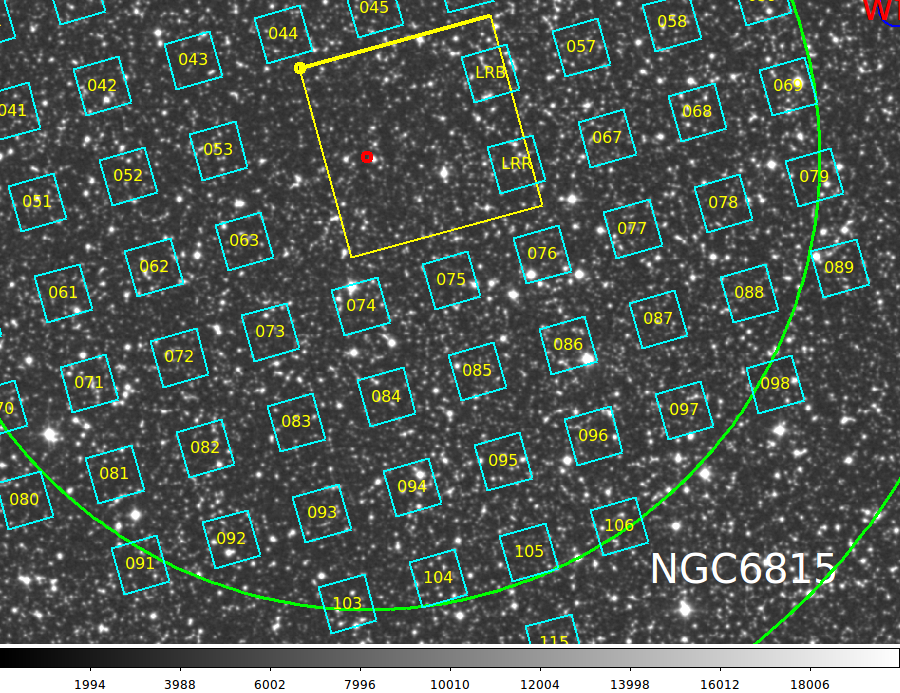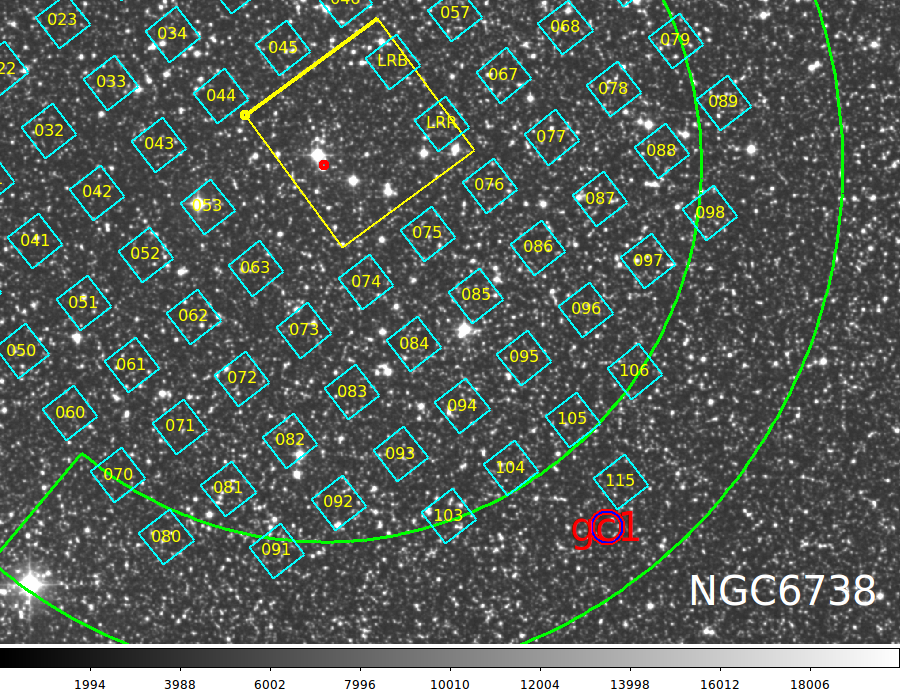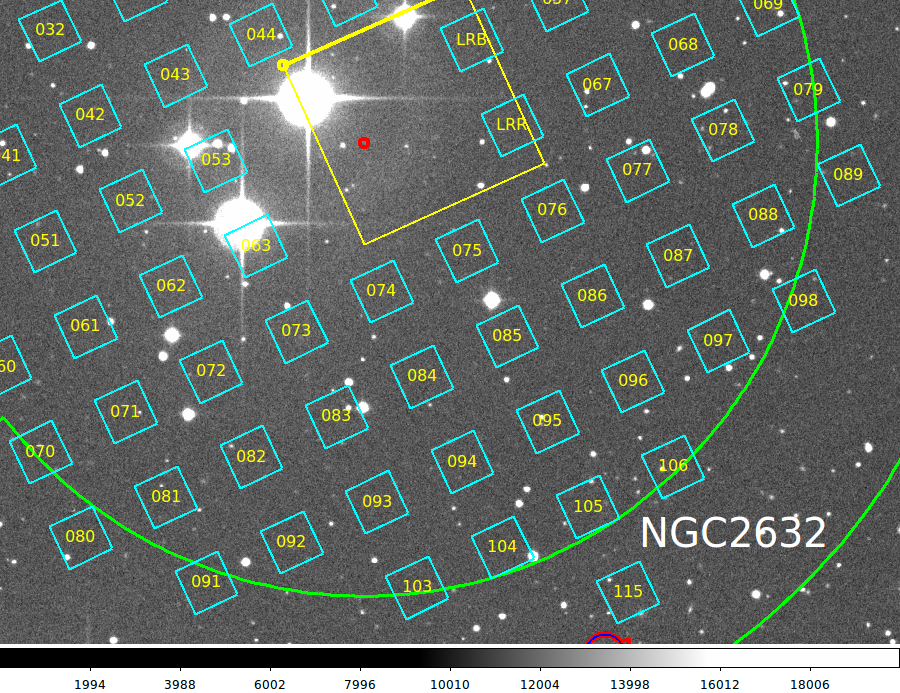A sample of VIRUS commissioning targets
The VIRUS and LRS2 commissioning work requires that we assemble
target fields with know astromtric positions. We'd like to grade
these targets by the number of stars (per IFU) each will provide,
as well as target availability in the April-May time period. Here
I demonstrate the methods used to gather our list in:
/home/sco/VIR+LRS_Apr2016/Targets
This will presumably beplaced in:
/home/sco/sco/projects/VIRUS/VIR+LRS_Apr2016/Targets
- Using the RNGC to get lists of clusters.
- Estimating star densities for each target.
- When are these target visible with HET?
- Sample finding charts.
Using the RNGC to get lists of clusters..
A text copy of the Revised NGC (RNGC) was obtained online for use
in making initial target lists for our commissioning run in Apr2016.
I show an example below of how I gather a list with
rngc. Below I assemble a
list of open clusters (last column = 1) and globular clusters
(last column = 2). The Ra,Dec ranges specified in the RADEC.LIMITS
file below are probably a little wide for mid-Spring, but we'll deal
with that later.
% rngc
Usage: rngc.sh 2 1
arg1 - object type (1=open cl. 2=glob.cl. 5=galaxy)
arg2 - Ra,Dec format (1=degrees, 2=sexigecimal)
% cat RADEC.LIMITS
8.0 20.0 -6.0 67.0
% rngc.sh 1 2 > List.0
% rngc.sh 2 2 >> List.0
% cat List.0
08:12:24.00 -05:43:00.0 1975.0 NGC2548 1
08:38:36.00 +20:05:00.0 1975.0 NGC2632 1
08:49:42.00 +11:54:00.0 1975.0 NGC2682 1
18:26:18.00 +06:33:00.0 1975.0 NGC6633 1
18:49:30.00 -05:14:00.0 1975.0 NGC6704 1
18:50:18.00 +10:19:00.0 1975.0 NGC6709 1
19:00:12.00 +11:34:00.0 1975.0 NGC6738 1
19:06:30.00 +04:10:00.0 1975.0 NGC6755 1
19:07:24.00 +04:37:00.0 1975.0 NGC6756 1
19:19:54.00 +37:48:00.0 1975.0 NGC6791 1
19:22:06.00 +22:08:00.0 1975.0 NGC6793 1
19:26:06.00 +25:05:00.0 1975.0 NGC6800 1
19:29:30.00 +20:13:00.0 1975.0 NGC6802 1
19:37:24.00 +46:30:00.0 1975.0 NGC6811 1
19:39:54.00 +26:47:00.0 1975.0 NGC6815 1
19:40:30.00 +40:08:00.0 1975.0 NGC6819 1
19:47:48.00 +21:09:00.0 1975.0 NGC6827 1
19:50:00.00 +23:01:00.0 1975.0 NGC6830 1
19:51:12.00 +29:21:00.0 1975.0 NGC6834 1
19:55:30.00 +30:17:00.0 1975.0 NGC6846 1
12:08:54.00 +18:41:00.0 1975.0 NGC4147 2
13:11:42.00 +18:18:00.0 1975.0 NGC5024 2
13:15:06.00 +17:48:00.0 1975.0 NGC5053 2
13:41:06.00 +28:30:00.0 1975.0 NGC5272 2
14:04:18.00 +28:39:00.0 1975.0 NGC5466 2
14:28:18.00 -05:52:00.0 1975.0 NGC5634 2
15:17:18.00 +02:11:00.0 1975.0 NGC5904 2
16:40:48.00 +36:30:00.0 1975.0 NGC6205 2
16:45:54.00 -01:55:00.0 1975.0 NGC6218 2
16:46:18.00 +47:34:00.0 1975.0 NGC6229 2
16:55:48.00 -04:04:00.0 1975.0 NGC6254 2
17:16:24.00 +43:10:00.0 1975.0 NGC6341 2
17:26:24.00 -05:03:00.0 1975.0 NGC6366 2
17:36:18.00 -03:16:00.0 1975.0 NGC6402 2
17:43:36.00 +03:11:00.0 1975.0 NGC6426 2
18:02:36.00 -00:18:00.0 1975.0 NGC6535 2
19:03:54.00 +01:50:00.0 1975.0 NGC6749 2
19:09:54.00 +00:59:00.0 1975.0 NGC6760 2
19:15:36.00 +30:08:00.0 1975.0 NGC6779 2
19:52:36.00 +18:43:00.0 1975.0 NGC6838 2
In the table above we now have Ra,Dec,Equinox, object name ,
and type code (1=open, 2=globular).
I can use precess_list
to get my coordinates into the J2000.0 equinox. This code typically
handle Ra,Dec,Eq,Name. In this case the Name+Type code will be
preserved as a single string (the "name") and we'll preserve
the type codes in our listing:
% precess_list List.0 2000.0 List.1
% cat List.1
08:13:38.0523 -05:47:34.784 2000.0 NGC2548 1 01:53
08:40:02.2224 +19:59:39.044 2000.0 NGC2632 1
08:51:04.0320 +11:48:20.840 2000.0 NGC2682 1
18:27:31.0529 +06:33:58.700 2000.0 NGC6633 1
18:50:49.8459 -05:12:11.188 2000.0 NGC6704 1
18:51:28.9366 +10:20:50.361 2000.0 NGC6709 1
19:01:22.2533 +11:36:11.352 2000.0 NGC6738 1 10:32
19:07:44.5294 +04:12:24.669 2000.0 NGC6755 1
19:08:38.2732 +04:39:26.549 2000.0 NGC6756 1
19:20:46.5088 +37:50:52.084 2000.0 NGC6791 1
19:23:10.1413 +22:10:56.790 2000.0 NGC6793 1
19:27:08.3180 +25:08:04.916 2000.0 NGC6800 1
19:30:35.4858 +20:16:11.857 2000.0 NGC6802 1 10:37
19:38:08.7886 +46:33:27.353 2000.0 NGC6811 1 10:18
19:40:55.5817 +26:50:32.590 2000.0 NGC6815 1
19:41:21.3583 +40:11:33.622 2000.0 NGC6819 1
19:48:53.3427 +21:12:48.164 2000.0 NGC6827 1
19:51:04.2792 +23:04:52.422 2000.0 NGC6830 1
19:52:12.2433 +29:24:54.683 2000.0 NGC6834 1
19:56:29.7766 +30:21:02.933 2000.0 NGC6846 1 10:45
12:10:10.4004 +18:32:39.329 2000.0 NGC4147 2
13:12:55.4562 +18:10:03.630 2000.0 NGC5024 2
13:16:19.4003 +17:40:05.992 2000.0 NGC5053 2
13:42:15.1021 +28:22:27.404 2000.0 NGC5272 2
14:05:25.4322 +28:31:51.443 2000.0 NGC5466 2 10:20
14:29:36.9630 -05:58:38.936 2000.0 NGC5634 2
15:18:33.9175 +02:05:34.447 2000.0 NGC5904 2
16:41:41.6144 +36:27:11.181 2000.0 NGC6205 2
16:47:11.9458 -01:57:37.863 2000.0 NGC6218 2
16:47:00.2042 +47:31:22.343 2000.0 NGC6229 2 07:27
16:57:07.1645 -04:06:17.155 2000.0 NGC6254 2
17:17:10.1056 +43:08:26.071 2000.0 NGC6341 2
17:27:43.7970 -05:04:11.765 2000.0 NGC6366 2
17:37:36.7772 -03:16:50.299 2000.0 NGC6402 2
17:44:51.0118 +03:10:25.536 2000.0 NGC6426 2
18:03:53.0406 -00:17:52.912 2000.0 NGC6535 2
19:05:09.8351 +01:52:19.241 2000.0 NGC6749 2
19:11:10.3102 +01:01:31.802 2000.0 NGC6760 2
19:16:34.5168 +30:10:43.325 2000.0 NGC6779 2 10:05
19:53:42.8806 +18:46:57.485 2000.0 NGC6838 2
Just for yuks I have manually added the htopx2 Start Time value
(UT times in BLUE text) for some of these objects computed
for the night of April 1,2016. We can see that most of our
clusters are observable in either the very start of the night or
the very end of the night. Start of the (dark) night is about 9pm,
and we can use the table below to see that the middle of the night
is very weak in open and globular clusters:
LST=05:56 UT=00:09 7pm
LST=06:45 UT=00:58 8pm
LST=10:45 UT=04:58 12am
LST=16:45 UT=10:58 6am
(made these estimates with skycal.sh)
Estimating star densities for each target.
Which targets will have the highest numbers of stars in the IFUs?
We can use the star_dens script to compute the number of stars per
sq.deg. gathers from USNOB1.0 in each of our fields. Because each
IFU is 50" on a side, this denisty corresponds roughly to the
number of stars we expect per IFU.
NOTE: For this project, it is best to use ALL targets (see below)
% cat SGV.values
0.0 11.5 19.5
% star_dens
Usage: star_dens filename file.out
arg1 = filename for list of [RAsex,DECsex,Name]
arg2 = Name of output file
% star_dens List.1 List.2
NOTE: This takes a few minutes to run, but what the hey.
% cat star_dens.explain
star_dens analysis for: List.1
Ra,Dec,b,Name,Density
% cat List.2
12:49:00.0000 +27:24:00.000 89.9999466 2000.0 NGalPole 0 0.70426
08:13:38.0523 -05:47:34.784 15.8052921 2000.0 NGC2548 1 4.06800
08:40:02.2224 +19:59:39.044 33.0886650 2000.0 NGC2632 1 1.37271
08:51:04.0320 +11:48:20.840 32.3738823 2000.0 NGC2682 1 1.71251
18:27:31.0529 +06:33:58.700 7.7687998 2000.0 NGC6633 1 12.03609
18:50:49.8459 -05:12:11.188 -2.7970443 2000.0 NGC6704 1 27.61020
18:51:28.9366 +10:20:50.361 4.1976800 2000.0 NGC6709 1 40.44843
19:01:22.2533 +11:36:11.352 2.6158173 2000.0 NGC6738 1 14.69318
19:07:44.5294 +04:12:24.669 -2.2104452 2000.0 NGC6755 1 14.14569
19:08:38.2732 +04:39:26.549 -2.1986613 2000.0 NGC6756 1 10.90848
19:20:46.5088 +37:50:52.084 10.6887817 2000.0 NGC6791 1 13.64197
19:23:10.1413 +22:10:56.790 2.9598231 2000.0 NGC6793 1 13.23771
19:27:08.3180 +25:08:04.916 3.5736103 2000.0 NGC6800 1 29.81211
19:30:35.4858 +20:16:11.857 0.5225502 2000.0 NGC6802 1 15.88128
19:38:08.7886 +46:33:27.353 11.7839298 2000.0 NGC6811 1 7.62591
19:40:55.5817 +26:50:32.590 1.7104149 2000.0 NGC6815 1 21.74375
19:41:21.3583 +40:11:33.622 8.2451458 2000.0 NGC6819 1 8.26969
19:48:53.3427 +21:12:48.164 -2.7115574 2000.0 NGC6827 1 25.80379
19:51:04.2792 +23:04:52.422 -2.1833515 2000.0 NGC6830 1 18.26780
19:52:12.2433 +29:24:54.683 0.8843585 2000.0 NGC6834 1 15.48418
19:56:29.7766 +30:21:02.933 0.5814683 2000.0 NGC6846 1 19.03971
12:10:10.4004 +18:32:39.329 77.4295120 2000.0 NGC4147 2 0.64776
13:12:55.4562 +18:10:03.630 79.2510986 2000.0 NGC5024 2 2.03002
13:16:19.4003 +17:40:05.992 78.4086227 2000.0 NGC5053 2 1.40534
13:42:15.1021 +28:22:27.404 78.1988525 2000.0 NGC5272 2 4.51841
14:05:25.4322 +28:31:51.443 73.1049423 2000.0 NGC5466 2 1.43956
14:29:36.9630 -05:58:38.936 48.7056046 2000.0 NGC5634 2 1.11408
15:18:33.9175 +02:05:34.447 46.1958885 2000.0 NGC5904 2 6.82377
16:41:41.6144 +36:27:11.181 40.5430145 2000.0 NGC6205 2 5.84496
16:47:11.9458 -01:57:37.863 25.7170563 2000.0 NGC6218 2 6.47522
16:47:00.2042 +47:31:22.343 40.0681725 2000.0 NGC6229 2 1.39818
16:57:07.1645 -04:06:17.155 22.4814911 2000.0 NGC6254 2 6.94552
17:17:10.1056 +43:08:26.071 34.5666122 2000.0 NGC6341 2 4.75396
17:27:43.7970 -05:04:11.765 15.4497557 2000.0 NGC6366 2 6.35506
17:37:36.7772 -03:16:50.299 14.2000246 2000.0 NGC6402 2 7.60601
17:44:51.0118 +03:10:25.536 15.6865158 2000.0 NGC6426 2 8.40179
18:03:53.0406 -00:17:52.912 9.8603449 2000.0 NGC6535 2 12.19366
19:05:09.8351 +01:52:19.241 -2.7225225 2000.0 NGC6749 2 10.07530
19:11:10.3102 +01:01:31.802 -4.4453001 2000.0 NGC6760 2 31.55963
19:16:34.5168 +30:10:43.325 8.0026865 2000.0 NGC6779 2 13.97699
19:53:42.8806 +18:46:57.485 -4.9351754 2000.0 NGC6838 2 24.35389
Notice that I am now referring to Name as "Equinox NGC# Type", but this is
okay. I'd like to carry this information around with each target. In my
new file (List.2) I have added the galactic latitude (b) in col03 and
the star density (# of star per sq.arcmin) in col07.
When are these target visible with HET?
Given a local sidereal time (LST) we'd like to know which
of our targets from the above list are visible. I use the
"my_targets" routine for this.
% cat List.2
% my_targets List.2 16:00:00
19:20:46.5088 +37:50:52.084 10.6887817 2000.0 NGC6791 1 1.60349 66.628
13:12:55.4562 +18:10:03.630 79.2510986 2000.0 NGC5024 2 0.73848 257.585
13:16:19.4003 +17:40:05.992 78.4086227 2000.0 NGC5053 2 0.62866 256.597
13:42:15.1021 +28:22:27.404 78.1988525 2000.0 NGC5272 2 2.48282 276.678
16:47:11.9458 -01:57:37.863 25.7170563 2000.0 NGC6218 2 2.85922 156.400
17:44:51.0118 +03:10:25.536 15.6865158 2000.0 NGC6426 2 0.53794 137.290
19:16:34.5168 +30:10:43.325 8.0026865 2000.0 NGC6779 2 0.10425 80.098
% cat my_targets.explain
# Targets from input HET list visible at LST = 16:00:00
# Name RA DEC AZhet
# line numbers of selected targets in Lines.Selected
As with the previous example, the "Name" is everything
after the Ra,Dec. I simply tack on the HET AZ a selected
obkect will be observed at (if it is selected to be
printed out). This script may seem a little klunky with
regard to global planning of a night. However, we often
want to know the answer to "What is visible now?", and this
fits the bill. With a little wrapper script,
I can use "my_targets" to get a good idea of what
an entire night might present. I make a file of LST times
(list.LST) that spans the start and end of my planned night. I
run the script "lists_by_lst":
% cat list.LST
08:00:00
09:00:00
10:00:00
11:00:00
12:00:00
13:00:00
14:00:00
15:00:00
16:00:00
17:00:00
% lists_by_lst List.2 list.LST
08:00:00 2 het-list.1
09:00:00 1 het-list.2
10:00:00 2 het-list.3
11:00:00 7 het-list.4
12:00:00 2 het-list.5
13:00:00 1 het-list.6
14:00:00 6 het-list.7
15:00:00 4 het-list.8
16:00:00 8 het-list.9
17:00:00 25 het-list.10
Suppose I want to see the object available around LST=11:00:00:
% cat het-list.4
LST = 11:00:00
08:40:02.2224 +19:59:39.044 33.0886650 2000.0 NGC2632 1 0.56977 261.145
08:51:04.0320 +11:48:20.840 32.3738823 2000.0 NGC2682 1 0.72893 244.387
13:12:55.4562 +18:10:03.630 79.2510986 2000.0 NGC5024 2 0.73848 102.415
13:16:19.4003 +17:40:05.992 78.4086227 2000.0 NGC5053 2 0.62866 103.403
13:42:15.1021 +28:22:27.404 78.1988525 2000.0 NGC5272 2 2.48282 83.322
14:05:25.4322 +28:31:51.443 73.1049423 2000.0 NGC5466 2 0.78941 83.041
Hence, I might consider observing NGC5272, at AZ=83.3, because it has a high
star density (2.48 per sq.arcmin) compared to the other available clusters.
Sample finding charts.
From the section above I can take a table of clusters that are
appropriate for a give time of night and make finding charts
for some of the fields. In the sample below I use the
LST=17:00:00 set (in het-list.10) and demo finding charts
for a high density cluster (NGC6815). I use a tool named "rot"
(RA Observing Tool) that allows the user to adjust the IHMP
center (to optimize the number of stars per IFU) and select
a guide star. In the table below, the estimate star density
(from V<19.5 USNOB1.0 stars) is in column 7.
% cat het-list.10
LST = 17:00:00
18:27:31.0529 +06:33:58.700 7.7687998 2000.0 NGC6633 1 0.63742 127.968
18:51:28.9366 +10:20:50.361 4.1976800 2000.0 NGC6709 1 2.22578 118.877
19:01:22.2533 +11:36:11.352 2.6158173 2000.0 NGC6738 1 0.38436 116.060
19:07:44.5294 +04:12:24.669 -2.2104452 2000.0 NGC6755 1 1.02416 134.292
19:08:38.2732 +04:39:26.549 -2.1986613 2000.0 NGC6756 1 1.11011 133.034
19:20:46.5088 +37:50:52.084 10.6887817 2000.0 NGC6791 1 1.60349 66.628
19:23:10.1413 +22:10:56.790 2.9598231 2000.0 NGC6793 1 0.37401 94.686
19:30:35.4858 +20:16:11.857 0.5225502 2000.0 NGC6802 1 3.24039 98.324
19:38:08.7886 +46:33:27.353 11.7839298 2000.0 NGC6811 1 1.30427 51.337
19:40:55.5817 +26:50:32.590 1.7104149 2000.0 NGC6815 1 7.35296 86.086
19:41:21.3583 +40:11:33.622 8.2451458 2000.0 NGC6819 1 0.16552 62.539
19:48:53.3427 +21:12:48.164 -2.7115574 2000.0 NGC6827 1 4.15792 96.520
19:51:04.2792 +23:04:52.422 -2.1833515 2000.0 NGC6830 1 3.40035 93.001
19:52:12.2433 +29:24:54.683 0.8843585 2000.0 NGC6834 1 0.69312 81.459
19:56:29.7766 +30:21:02.933 0.5814683 2000.0 NGC6846 1 0.42176 79.792
13:42:15.1021 +28:22:27.404 78.1988525 2000.0 NGC5272 2 2.48282 276.678
14:05:25.4322 +28:31:51.443 73.1049423 2000.0 NGC5466 2 0.78941 276.959
15:18:33.9175 +02:05:34.447 46.1958885 2000.0 NGC5904 2 3.55552 219.377
16:57:07.1645 -04:06:17.155 22.4814911 2000.0 NGC6254 2 4.07835 172.798
17:27:43.7970 -05:04:11.765 15.4497557 2000.0 NGC6366 2 4.03219 180.000
17:37:36.7772 -03:16:50.299 14.2000246 2000.0 NGC6402 2 4.21044 164.368
18:03:53.0406 -00:17:52.912 9.8603449 2000.0 NGC6535 2 0.11300 149.044
19:16:34.5168 +30:10:43.325 8.0026865 2000.0 NGC6779 2 0.10425 80.098
19:53:42.8806 +18:46:57.485 -4.9351754 2000.0 NGC6838 2 1.53505 101.207
 |
A finding chart for NGC6815 generated with:
rot NGC6815 19:40:55.5817 +26:50:32.590 86.086
This cluster was selected from the LST=17:00:00 group
(previous section) as being a HIGH stellar density field.
In addition to revising the IHMP position for this
field (small red circle) the user may select a guide star.
|
 |
A finding chart for NGC6738 generated with:
rot NGC6738 19:01:22.2533 +11:36:11.352 116.060
This cluster was selected from the LST=17:00:00 group
(previous section) as being a LOW stellar density field.
|
Star density values not sensitive?
It would appear that the density of usable IFU stars does not vary
greatly. This is probably due to the large field gathered from
the USNOB1.0 catalog (Radius = 24' in diameter) and the fairly
bright magnitude cut of V.le.19.5 . Actually, digging a little
deeper reveals that the problem is poor star/gal separation in
USNOB1.0 at low galactic latitudes. I just use usno_look to
view few fields:
Cluster fields
rot NGC6815 19:40:55.5817 +26:50:32.590 86.086
rot NGC6738 19:01:22.2533 +11:36:11.352 116.060
low density field
rot NGP1 12:30:22.2533 +31:36:11.352 -999
rot NGP2 12:30:22.2533 +21:36:11.352 -999
I can visually see a difference, does star_dens?
% star_dens l.1 OUT
% cat OUT
19:40:55.5817 +26:50:32.590 1.7104149 s1 7.35296
19:01:22.2533 +11:36:11.352 2.6158173 s2 0.38436
12:30:22.2533 +31:36:11.352 84.1621399 n1 0.28489
12:30:22.2533 +21:36:11.352 82.8211365 n2 0.34855
ANSWER: No!
Here we use the ds9 region files (bote STAR and GALS) from usno_look:
CLUSTERS at b < 5 degrees
% usno_look 19:40:55.5817 +26:50:32.590 12.0 19.5
wc -l *reg
6285 gals.reg
2851 stars.reg
9136 total
% usno_look 19:01:22.2533 +11:36:11.352 12.0 19.5
wc -l *reg
6558 gals.reg
144 stars.reg
6702 total
NGP fields (b > 80 degrees)
NGP1
% usno_look 12:30:22.2533 +31:36:11.352 12.0 19.5
wc -l *reg
147 gals.reg
132 stars.reg
279 total
NGP2
% usno_look 12:30:22.2533 +21:36:11.352 12.0 19.5
wc -l *reg
290 gals.reg
164 stars.reg
454 total
Hence, I'll tune up the star_dens code to take this into account.
It appear that all I need to do is change the stellarity range
for selecting stars. In multi_usno_runs I now use:
# For now hard code the sglo,sghi,Vlim values
sglo="5.5"
sghi="11.5"
Vlim="19.5"
if [ -s "SGV.values" ]
then
read sglo sghi Vlim < SGV.values
fi
In other words, I create a local file (SGV.values) that sets the
stellary values such that I count ALL sources (stellarity between 0 and 11)
and use this to compute the density of targets. After these changes
I get the following results:
% ls
list.1 SGV.values
% cat list.1
19:40:55.5817 +26:50:32.590 NGC6815
19:01:22.2533 +11:36:11.352 NGC6738
12:30:22.2533 +31:36:11.352 NGalPole1
12:30:22.2533 +21:36:11.352 NGalPole2
% cat SGV.values
0.0 11.5 19.5
% star_dens list.1 Out.Star_Densities
% cat Out.Star_Densities
19:40:55.5817 +26:50:32.590 1.7104149 NGC6815 21.74375
19:01:22.2533 +11:36:11.352 2.6158173 NGC6738 14.69318
12:30:22.2533 +31:36:11.352 84.1621399 NGalPole1 0.66765
12:30:22.2533 +21:36:11.352 82.8211365 NGalPole2 0.97960
Now we see a very pronounced distinction in the densities
levels between the low (cluster) and the high (NGP) latitude fields!
Hence, I'll re-run some of the examples above to get more useful
star density estimates in selecting target fields.
 |
A finding chart for NGC2632 generated with:
rot NGC2632 08:40:02.22 +19:59:39.0 1.37
This cluster field was processed uing the SGV.values file to
reset the stellarity ranges for star-galaxy separation in
USNOB1.0. This produces more reliable stellar density estimates.
The star denisty for this field was dens=1.37, compared to the
values of dens=21.7,14.7 for the fields show above. Clearly
our star density values now help in identifying fields with
high star density. In addition to revising the IHMP position for this
field (small red circle) the user may select a guide star.
|
Return to calling page


